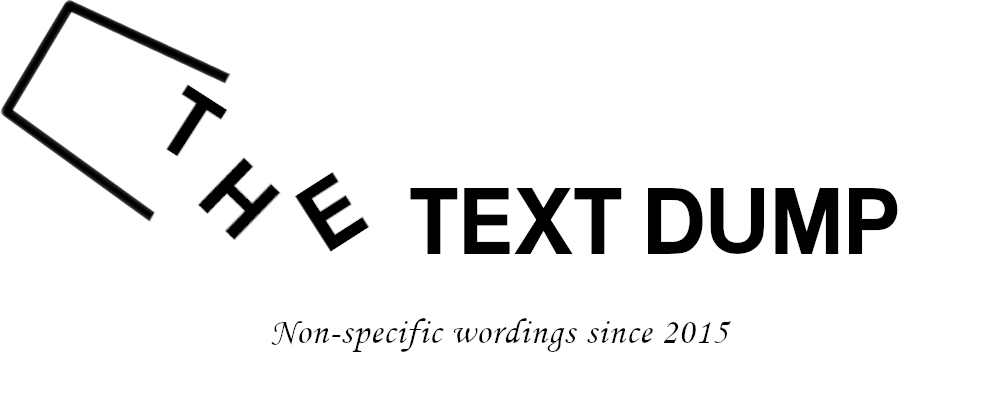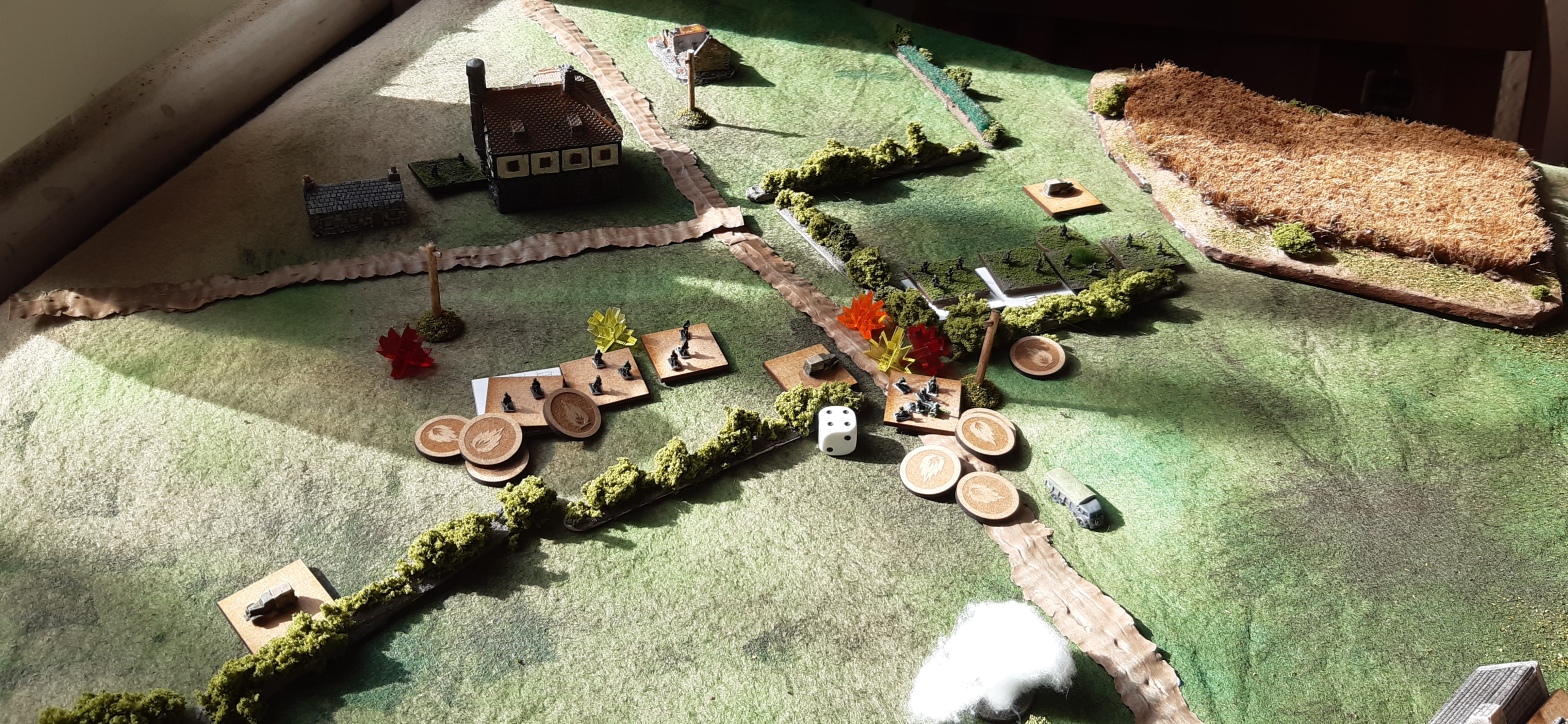I’m going to start by making a broad assumption: the majority of people reading this blog post (if you’re reading it when published) are either under some form of lockdown or being told to social-distance themselves where possible. It’s important at times like this to remember our liberties – we’re being asked to stay at home and keep ourselves entertained, we can still go out when needs must, we have fully working electricity and gas and internet connections to keep us comfortable and entertained; things could be far worse. Regardless, being socially-isolated isn’t easy, and it’s important that we do things to look after ourselves.
These days I’d say I’m more of a tabletop gamer than a PC gamer, and the former is an itch that isn’t going to be scratched for quite some time now. Efforts have to be made to overcome this by a few people, however we see fit. There’s always been a considerable chunk of the wargaming community that enjoys solo-play, and I’ve seen a number of people touch on this in recent days.
There’s also play-by-post or play-by-email games. Bit more old school, but there’s plenty of fun to be had doing these. I’d just joined a play-by-post game myself, but we’ve had to postpone due to the current climate.
I’d seen Twitter accounts run ‘choose your own adventure’ threads, polling the readers on what to do next; I’d also seen this used for hex-and-counter games, explaining the situation and polling for the next command decision. Polls are as easy as a press of a button on Twitter, so the admin of running such a thing is minor. What I hadn’t seen was a miniatures wargame run this way. It just so happened that I’d got enough 6mm minis for a French v German game set in 1940, and decided ‘why not?’ I have the space to run a game of Chain of Command, and certainly have the free time now that we can’t really go anywhere. I started by laying out a simple, relatively balanced table, making it black and white (aerial recon!) and labelling two table edges.
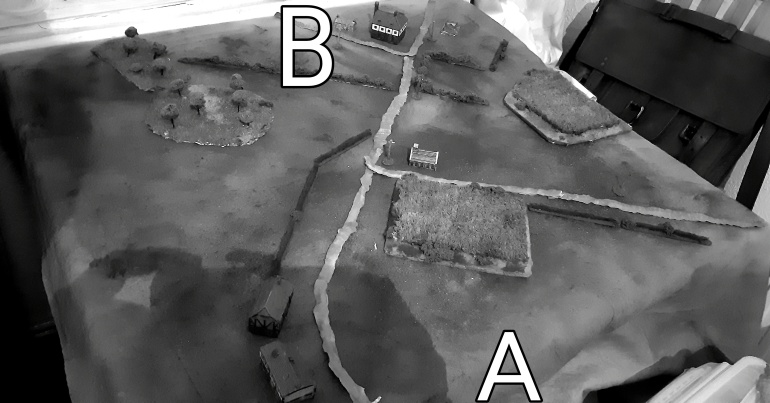
Rather than do anything too adventurous or lengthy to begin with, the game would simply be ‘beat the French’ with little in the way of support. There were a number of support options available so I put it to a vote, the Panzer 38T being taken (I should add that there was no indication as to what support the French had, German intelligence merely said that they had no armour available.) This recon picture gave us the first opportunity for a gaming vote – how should you undertake the patrol phase? Three options – left, centre, right – and left won quite comfortably. I’d also asked Twitter to vote on initial orders, so that there was scope to get the game moving. They chose to advance to contact through the woods.
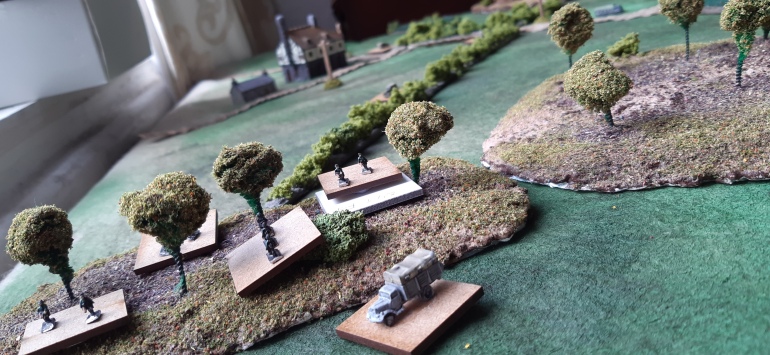
The first difficulty I found was when to post a poll for a command decision, and when to keep running the game myself. Playing the game for too long with a poll would take away the agency of things, but voting slows things down a lot. I tested different lengths of time for voting, the shortest being 90 minutes and the longest 3 hours. You’re relying on people regularly checking their twitter feed to find out there’s a poll; they need plenty of time to do so, but if you leave it too long you restrict the amount of actual gaming you’ll get to do. In the end I settled for 2 and a half hours as the voting timeframe.
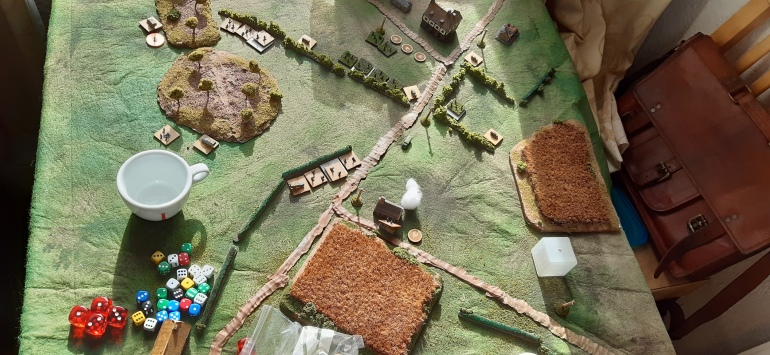
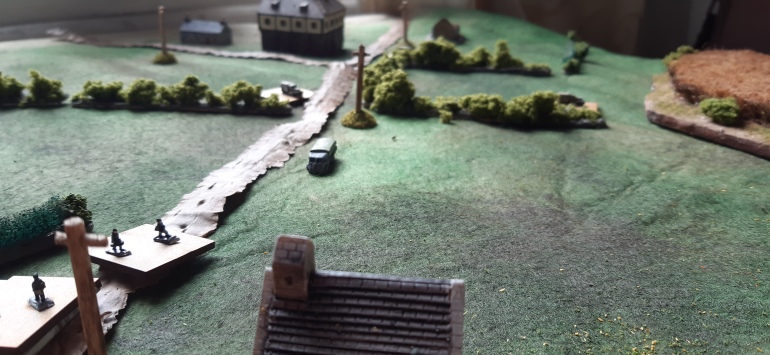
The battle took a few interesting turns. The French faced much more friction than the Germans did as they had one fewer command dice at the start, and only one senior leader. French dice-rolling also seemed to be a lot more erratic – as one German squad advanced a French section managed to fire and take out 4 Germans in a single phase, only to not land another meaningful hit for the rest of the turn. Moments like this felt like they would be crucial command decisions, so I’d open it up to Twitter and ask if they wanted to bring on the mortar team, for example. German losses were significant, and as their tank couldn’t come on immediately this lent itself to a further command decision – press on, fall back, or hold tight and wait for the tank? Unsurprisingly they went for the tankiest option possible. This was about the time of day in the real world when it was getting dark outside, and as the lighting in the room isn’t the best I decided to make a ‘Sitrep’ image that was annotated, making an overnight poll about how the tank should be used.
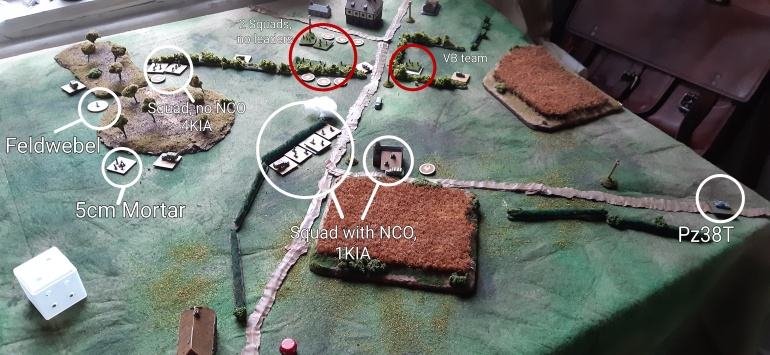
The following morning the fight carried on with surprising pace. Using the ‘Blitzkrieg’ Chain of Command book gives French reserve platoons such as this quite a major command challenge as they don’t have the level of control their German rivals do at any given time, and once force morale begins to dip their control gets even more restrictive, losing command dice and jump-off points. Soon enough the French had thrown every last reserve onto the table, including their AT gun, but even that does little to dent the German advance, who rout the French from the field as they clamber over the hedgerows.
I’d expected for the game to take up much of my day, but it was over quickly! I was free to tidy things away by lunch, and reflected on how things had gone, asking those who had joined in for some feedback. The consensus was that the game was good fun, but that the nature of 6mm meant it was difficult at times to discern who was who. I think semi regular ‘sitrep’ images, maybe using NATO markers over the picture, would help a lot with this; I’ll have to see whether I can find an app for my phone that will do this.
There seems to be quite a lot in common with running a game like this via twitter and DMing an RPG, such as Dungeons and Dragons. Essentially you’re laying a narrative out, adding colour and flair, then asking your players what they want to do. Not making the French support options clear was subconsciously part of this, and could certainly be made into a bigger thing, with intelligence reports and even recon photos, time-permitting.
It’s important to consider how the length of each votes ties you down to the game. Momentum and regular tweeting is important to maintain interest, which means making sure you’re free the moment your current poll finishes to put plans into action. A short voting time – say 90 minutes – will restrict what you can do with your time while waiting. Not a problem on a lazy Saturday, perhaps, but if you have things you need to do that day then you may want to think twice. Longer voting times can help, but they also make the game take much much longer.
A nice takeaway from playing such a game, though, is having a great excuse to set up a table and take lots of photos of it without having to ask your opponent if you can stop playing for a minute to do so. This means time to take pictures with interesting angles, too, though you want to have a regular angle that shows the whole game, to help keep your players informed. Taking loads of pictures has also spurred me onto getting around to properly basing all those minis, a job I normally put off for as long as I possibly can.
Would I run a play-by-vote game again? Absolutely! I’d like to think the lessons learned from this one will help run a better game next time. Depending on how long we’re all stuck at home this could potentially develop into a campaign, though looking through the support lists for the ‘Gembloux Gap’ campaign I may need to buy a few more minis first. Then again, who doesn’t like an excuse to buy a few more minis?
